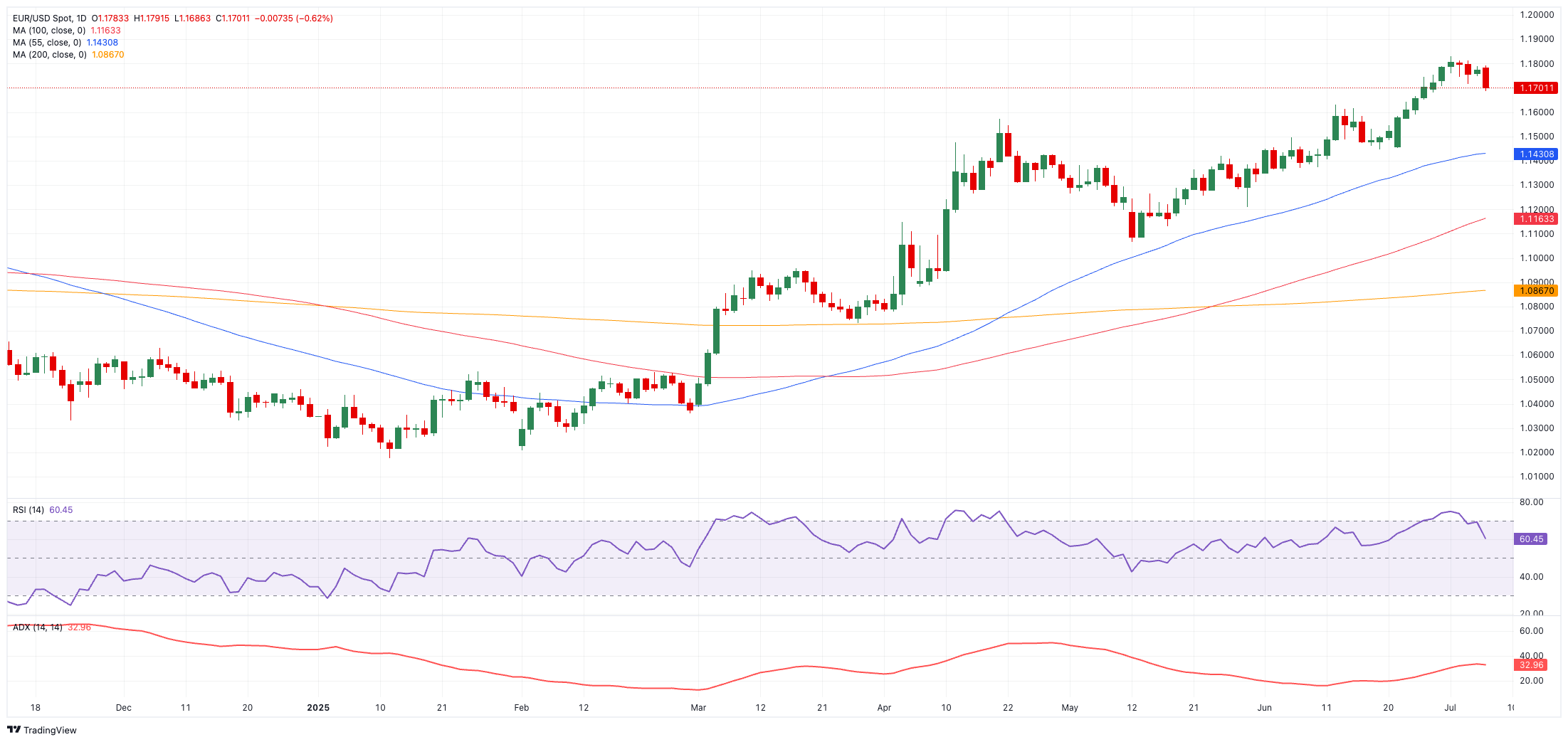
- EUR/USD continued to decline, retreating to multi-day lows in the sub-1.1500 region.
- The US Dollar picked up extra pace on the back of the resumption of trade jitters.
- President Trump delayed the tariffs deadline to August 1.
The Euro (EUR) resumed its slide against the US Dollar (USD) at the beginning of the new trading week, with EUR/USD slipping to multi-day lows in the 1.1690–1.1680 range amid renewed concerns on the trade front. The pair’s daily retracement came on the back of rising US and German yields across the board.
Political pressure on the Fed
Market participants seem to have parked concerns over the Fed’s independence for now, all following President Trump’s renewed calls for interest rates as low as “1% or lower” and his criticism of Fed Chair Jerome Powell and his monetary policy decisions.
Geopolitics and risk sentiment
A fragile ceasefire in the Middle East brokered by President Trump in late June briefly boosted risk appetite, weighing on the Greenback and lending temporary strength to the European currency and other risk-linked currencies.
Trade tensions are back
Despite the White House kicking back the tariffs deadline to August 1, investors remain watchful. On this, the EU is negotiating several trade deals, including talks with the UK. Earlier on Monday, Trump announced 25% levies on Japan and South Korea, reigniting concerns and lending extra wings to the US Dollar.
Policy divergence on hold
The Federal Reserve (Fed) held rates at 4.25%–4.50% in June, upgraded its inflation and unemployment forecasts, and signalled 50 basis points of easing this year.
In contrast, the European Central Bank (ECB) cut its deposit rate to 2.00% earlier this month, with President Lagarde warning any further easing would hinge on a clear drop in external demand.
Coming events
On July 8, Germany will release its balance of trade figures, and on July 10, it will release the final Inflation Rate for the month of June. The Current Account readings and Wholesale Prices will round off the calendar on July 11.
Technical landscape
Immediate resistance lies at the 2025 ceiling of 1.1830 (July 1), ahead of the September 2018 high of 1.1815 (September 24) and the June 2018 peak of 1.1852 (June 14).
On the downside, the 55-day simple moving average (SMA) at 1.1428 offers interim support, ahead of the weekly trough of 1.1210 (May 29) and the May floor of 1.1064 (May 12), all above the psychological 1.1000 mark.
Additionally, the Relative Strength Index (RSI), which is near 61, indicates that conditions are stretched but still leaning upward, while an Average Directional Index (ADX) reading above 33 suggests a strengthening trend.

Medium-term view
Absent fresh geopolitical or macro shocks, the uptrend in EUR/USD is likely to resume, underpinned by ebbing risk aversion and the prospect of further Fed easing.
However, trade concerns and their impact on global growth remain a critical headwind as markets enter the second half of the year, all underpinned by President Trump’s zigzagging views on global trade.
US-China Trade War FAQs
Generally speaking, a trade war is an economic conflict between two or more countries due to extreme protectionism on one end. It implies the creation of trade barriers, such as tariffs, which result in counter-barriers, escalating import costs, and hence the cost of living.
An economic conflict between the United States (US) and China began early in 2018, when President Donald Trump set trade barriers on China, claiming unfair commercial practices and intellectual property theft from the Asian giant. China took retaliatory action, imposing tariffs on multiple US goods, such as automobiles and soybeans. Tensions escalated until the two countries signed the US-China Phase One trade deal in January 2020. The agreement required structural reforms and other changes to China’s economic and trade regime and pretended to restore stability and trust between the two nations. However, the Coronavirus pandemic took the focus out of the conflict. Yet, it is worth mentioning that President Joe Biden, who took office after Trump, kept tariffs in place and even added some additional levies.
The return of Donald Trump to the White House as the 47th US President has sparked a fresh wave of tensions between the two countries. During the 2024 election campaign, Trump pledged to impose 60% tariffs on China once he returned to office, which he did on January 20, 2025. With Trump back, the US-China trade war is meant to resume where it was left, with tit-for-tat policies affecting the global economic landscape amid disruptions in global supply chains, resulting in a reduction in spending, particularly investment, and directly feeding into the Consumer Price Index inflation.
Information on these pages contains forward-looking statements that involve risks and uncertainties. Markets and instruments profiled on this page are for informational purposes only and should not in any way come across as a recommendation to buy or sell in these assets. You should do your own thorough research before making any investment decisions. FXStreet does not in any way guarantee that this information is free from mistakes, errors, or material misstatements. It also does not guarantee that this information is of a timely nature. Investing in Open Markets involves a great deal of risk, including the loss of all or a portion of your investment, as well as emotional distress. All risks, losses and costs associated with investing, including total loss of principal, are your responsibility. The views and opinions expressed in this article are those of the authors and do not necessarily reflect the official policy or position of FXStreet nor its advertisers. The author will not be held responsible for information that is found at the end of links posted on this page.
If not otherwise explicitly mentioned in the body of the article, at the time of writing, the author has no position in any stock mentioned in this article and no business relationship with any company mentioned. The author has not received compensation for writing this article, other than from FXStreet.
FXStreet and the author do not provide personalized recommendations. The author makes no representations as to the accuracy, completeness, or suitability of this information. FXStreet and the author will not be liable for any errors, omissions or any losses, injuries or damages arising from this information and its display or use. Errors and omissions excepted.
The author and FXStreet are not registered investment advisors and nothing in this article is intended to be investment advice.








